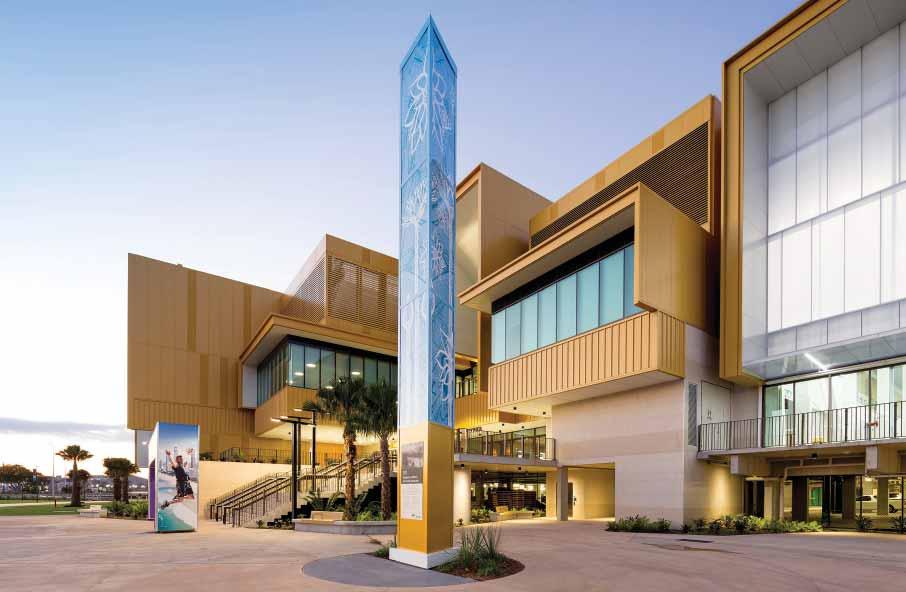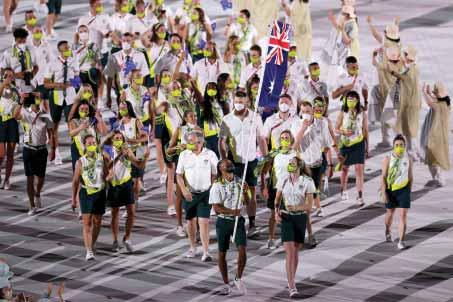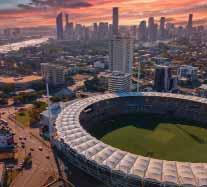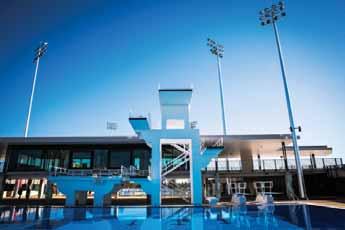
6 minute read
Ensuring the Right Legacy
Gold Coast Sport and Leisure Centre. A legacy of the 2018 Commonwealth Games (above) while Brisbane’s Gabba is set to be the main venue for the 2032 Olympics (below).
Jason Leslie believes that maximising post-Games usage is essential for facilities built for the Brisbane 2032 Olympics and Paralympics
Advertisement
Following the recent exciting announcement of Brisbane as the host city for the 2032 Olympic and Paralympic Games, there has been much discussion about ensuring legacy outcomes are maximised. In fact, Games organisers are aiming for an integrated and effectively implemented Games legacy program delivered over a sustained twenty-year period. The International Olympic Committee is committed to changing the way Olympic Games have previously been organised by ensuring sustainability outcomes, reducing the cost of delivery and maximising synergies with stakeholders through programs such as the Active Well-being Initiative.
Throughout my recent travels across Queensland working with our local government clients, it seems almost all Councils are already discussing the opportunities the Games could bring to their communities. I have lost count of the number of times a local government representative has said to me, “we are going to build it to attract Olympic and Paralympic teams in the lead up to the Games.”
Legacy planning of venues as part of a major sporting event has often not understood the specific needs of the sports involved and/or surrounding catchments. There are many examples from around the world and here in Australia where these types of facilities have failed to best meet ongoing community needs post-Games and/or have proven costly to maintain.
Understanding community sport and recreation facility needs from local to national levels, and how Olympic facilities can maximise their post-Games usage and viability by responding to them, is an essential ingredient of early design. This understanding can inform the mix of permanent and temporary infrastructure that caters for the Games but reduces the wholeof-life cost burden to the post-event asset owner.
While it is true the Games will present an unprecedented opportunity for Queensland, several key factors should be at the forefront of any local government seeking to invest in sports infrastructure as a means of attracting Olympic and Paralympic teams before the Games.
The first question that must be answered is ‘why’? What is the reason for investment in sports infrastructure to attract pre-Olympic training or other Games-related activities? Is
Australia’s team at the opening ceremony for this year’s Tokyo Games. Credit: Getty.



The 2000 Games created a legacy of sport, entertainment and recreation facilities at Sydney Olympic Park. 2018 Commonwealth Games venues the Gold Coast Sport and Leisure Centre and Metricon Stadium.


it part of a strategy for securing external funding support for infrastructure local government cannot typically fund? Is it as part of broader tourism or economic strategy? Is it to improve community health via encouraging increased physical activity? Understanding the why will assist to ensure investment in the right type of infrastructure.
Understanding the funding environment and opportunities is critically important. With Queensland being one of the few States or Territories without a major sport and recreation infrastructure fund, the overall funding environment for major sports facilities will likely remain difficult. The focus of sports infrastructure funding by the Queensland Government between now and the 2032 is likely to be for projects that can demonstrate a clear and legitimate alignment with the Games.
Another factor for consideration is what is the legacy outcome a local government is seeking from investment in sports infrastructure as a strategy to attract pre-Olympic teams to its region? From the discussions I’ve recently held with several councils, it appears the facility provision and design focus are on what the Games teams will need first. This is the wrong way around. The focus in the planning and design of sports infrastructure should be based on what will maximise the community use and viability of a facility before and post the Games. Getting this right first must be the objective. Once this is achieved, the focus should only then start to think about the subtle changes that can be made to the facility mix and design that will also act as an attractor to Games teams and nations. I often share the great anecdote with my clients of, ‘don’t build for Christmas Day’.
One of the other key considerations must be to focus on the sport and activities that align to the existing strengths of the community, destination, infrastructure and services. Developing infrastructure for sports that will likely be attracted to other destinations will result in the wrong type of legacy being achieved. Most local governments in Queensland will be seeking funding to develop Games aligned facilities. Councils will also be seeking to secure as many teams and nations as possible to their local government area in the lead up to the Games. Both the available funding environment and the ability to attract nations and teams to a destination before the Games will be highly competitive. It is important Councils avoid unnecessary duplication of facilities with surrounding local governments and concentrate opportunities that showcase their unique strengths and character.
So, how can local government in Queensland become part of the Games and maximise legacy outcomes? The answer is by taking a multi-faceted approach to planning around Games opportunities. Understand the broader Queensland network of major sporting infrastructure supply, including what is currently available and plans for the development of new facilities. Create a strategy that focusses on the unique strengths and character of the Council area. Don’t compete in spaces that others do better or are better located to deliver. Ensure facility planning and design aims first to maximise community use and viability before exploring the needs of teams pre-Games. Ensure planning around Games opportunities aligns with the broader strategic planning context of the local government area by ensuring consistency with other plans and strategies and identifying opportunities to maximise economic and tourism outcomes as a result of the Games.
In conclusion, to maximise the usage and sustainability of post-Games sporting facilities it is critical that the infrastructure is able to respond to the current and projected needs of catchments and integrate with other sport and recreation plans of local governments. Pitfalls should be avoided that make sporting venues more difficult to manage, be underutilised, or less viable. Facilities need to be the right-size, with components that enhance usage and viability and avoid costly maintenance of permanent, but seldom used, infrastructure. Hands-on, contemporary venue management perspectives need to be employed in the planning and design phase so that facilities can be flexible and can respond to emerging sport and recreation trends and changing participation patterns over time. Spaces need to be provided that support the delivery of programs and services for sporting groups and the broader community and must cater for realistic future sporting events. With over 25 years’ experience in sport planning and management, Jason Leslie is a Director of Otium Planning Group and previously held senior management positions with the Queensland Department of Sport and Recreation. He can be contacted on jason@otiumplanning.com.au











